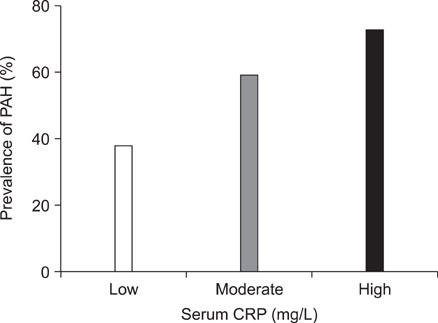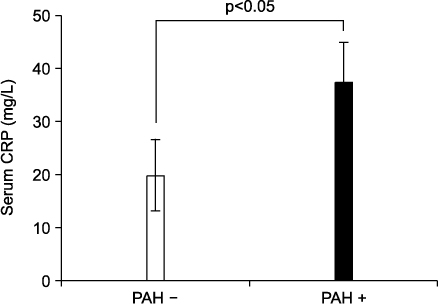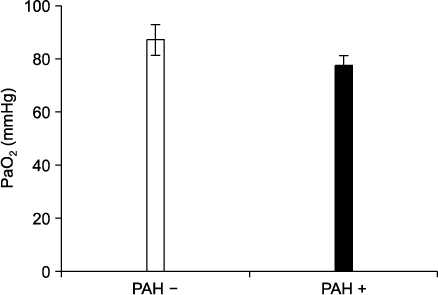Tuberc Respir Dis.
2008 Feb;64(2):125-132.
Elevated C-reactive Protein Levels are a Sign of Pulmonary Arterial Hypertension in AECOPD
- Affiliations
-
- 1Department of Internal Medicine, Chonbuk National University Medical School, Jeonju, Korea. ryk@chonbuk.ac.kr
- 2Airway Remodeling Laboratory, Chonbuk National University Medical School, Jeonju, Korea.
Abstract
-
BACKGROUND: In chronic obstructive pulmonary disease (COPD) patients, the serum levels of C-reactive protein (CRP) are elevated and an increase of CRP is more exaggerated in the acute exacerbation form of COPD (AECOPD) than in stable COPD. Pulmonary arterial hypertension is a common complication of COPD. An increased level of CRP is known to be associated with the risk of systemic cardio-vascular disorders. However, few findings are available on the potential role of CRP in pulmonary arterial hypertension due to COPD.
METHODS
This study was performed prospectively and the study population was composed of 72 patients that were hospitalized due to AECOPD. After receiving acute management for AECOPD, serum CRP levels were evaluated, arterial oxygen pressure (PaO2), was measured, and the existence of pulmonary arterial hypertension under room air inhalation was determined in the patients.
RESULTS
The number of patients with pulmonary arterial hypertension was 47 (65.3%)., There was an increased prevalence of pulmonary arterial hypertension and an increase of serum CRP levels in patients with the higher stages of COPD (e.g., patients with stage 3 and stage 4 disease; P<0.05). The mean serum CRP levels of patients with pulmonary arterial hypertension and without pulmonary arterial hypertension were 37.6+/-7.4 mg/L and 19.9 +/-6.6 mg/L, respectively (P<0.05). However, there was no significant difference of the mean values of PaO2 between patients with pulmonary arterial hypertension and without pulmonary arterial hypertension statistically (77.8+/-3.6 mmHg versus 87.2+/-6.0 mmHg).
CONCLUSION
We conclude that higher serum levels of CRP can be a sign for pulmonary arterial hypertension in AECOPD patients.
MeSH Terms
Figure
Reference
-
1. Barnes PJ, Shapiro SD, Pauwels RA. Chronic obstructive pulmonary disease: molecular and cellular mechanisms. Eur Respir J. 2003. 22:672–688.2. Fabbri LM, Rabe KF. From COPD to chronic systemic inflammatory syndrome? Lancet. 2007. 370:797–799.3. Barnes PJ. Chronic obstructive pulmonary disease. N Engl J Med. 2000. 343:269–280.4. Vernooy JH, Küçükaycan M, Jacobs JA, Chavannes NH, Buurman WA, Dentener MA, et al. Local and systemic inflammation in patients with chronic obstructive pulmonary disease: soluble tumor necrosis factor receptors are increased in sputum. Am J Respir Crit Care Med. 2002. 166:1218–1224.5. Gan WQ, Man SF, Senthilselvan A, Sin DD. Association between chronic obstructive pulmonary disease and systemic inflammation: a systematic review and a meta-analysis. Thorax. 2004. 59:574–580.6. Pinto-Plata VM, Müllerova H, Toso JF, Feudjo-Tepie M, Soriano JB, Vessey RS, et al. C-reactive protein in patients with COPD, control smokers and non-smokers. Thorax. 2006. 61:23–28.7. Eid AA, Ionescu AA, Nixon LS, Lewis-Jenkins V, Matthews SB, Griffiths TL, et al. Inflammatory response and body composition in chronic obstructive pulmonary disease. Am J Respir Crit Care Med. 2001. 164:1414–1418.8. Barberá JA, Peinado VI, Santos S. Pulmonary hypertension in chronic obstructive pulmonary disease. Eur Respir J. 2003. 21:892–905.9. Wright JL, Levy RD, Churg A. Pulmonary hypertension in chronic obstructive pulmonary disease: current theories of pathogenesis and their implications for treatment. Thorax. 2005. 60:605–609.10. Barberá JA, Riverola A, Roca J, Ramirez J, Wagner PD, Ros D, et al. Pulmonary vascular abnormalities and ventilation-perfusion relationships in mild chronic obstructive pulmonary disease. Am J Respir Crit Care Med. 1994. 149:423–429.11. Peinado VI, Barberá JA, Abate P, Ramírez J, Roca J, Santos S, et al. Inflammatory reaction in pulmonary muscular arteries of patients with mild chronic obstructive pulmonary disease. Am J Respir Crit Care Med. 1999. 159:1605–1611.12. Stevens T, Janssen PL, Tucker A. Acute and long-term TNF-alpha administration increased pulmonary vascular reactivity in isolated rat lungs. J Appl Physiol. 1992. 73:708–712.13. Fujita M, Shannon JM, Irvin CG, Fagan KA, Cool C, Augustin A, et al. Overexpression of tumor necrosis factor-alpha produces an increase in lung volumes and pulmonary hypertension. Am J Physiol Lung Cell Mol Physiol. 2001. 280:L39–L49.14. Ortiz LA, Lasky J, Hamilton RF Jr, Holian A, Hoyle GW, Banks W, et al. Expression of TNF and the necessity of TNF receptors in bleomycin-induced lung injury in mice. Exp Lung Res. 1998. 24:721–743.15. Dorfmüller P, Perros F, Balabanian K, Humbert M. Inflammation in pulmonary arterial hypertension. Eur Respir J. 2003. 22:358–363.16. Lakoski SG, Cushman M, Palmas W, Blumenthal R, D'Agostino RB Jr, Herrington DM. The relationship between blood pressure and C-reactive protein in the Multi-Ethnic Study of Atherosclerosis (MESA). J Am Coll Cardiol. 2005. 46:1869–1874.17. Venugopal SK, Devaraj S, Yuhanna I, Shaul P, Jialal I. Demonstration that C-reactive protein decreases eNOS expression and bioactivity in human aortic endothelial cells. Circulation. 2002. 106:1439–1441.18. Verma S, Li SH, Badiwala MV, Weisel RD, Fedak PW, Li RK, et al. Endothelin antagonism and interleukin-6 inhibition attenuate the proatherogenic effects of C-reactive protein. Circulation. 2002. 105:1890–1896.19. Joppa P, Petrasova D, Stancak B, Tkacova R. Systemic inflammation in patients with COPD and pulmonary hypertension. Chest. 2006. 130:326–333.20. Leopold JG, Gough J. The centrilobular form of hypertrophic emphysema and its relation to chronic bronchitis. Thorax. 1957. 12:219–235.21. Riely DJ, Thakker-Varia S, Poiani GJ, Tozzi CA. Crystal RG, West JB, Barnes PJ, Weibel ER, editors. Vascular remodeling. The lung: scientific foundations. 1977. Philadelphia: Lippincott-Raven;1589–1568.22. MacNee W. Pathophysiology of cor pulmonale in chronic obstructive pulmonary disease: part two. Am J Respir Crit Care Med. 1994. 150:1158–1168.23. Skjaerpe T, Hatle L. Diagnosis of tricuspid regurgitation. Sensitivity of Doppler ultrasound compared with contrast echocardiography. Eur Heart J. 1985. 6:429–436.24. Yock PG, Popp RL. Noninvasive estimation of right ventricular systolic pressure by Doppler ultrasound in patients with tricuspid regurgitation. Circulation. 1984. 70:657–662.25. Tramarin R, Torbicki A, Marchandise B, Laaban JP, Morpurgo M. Doppler echocardiographic evaluation of pulmonary artery pressure in chronic obstructive pulmonary disease. A European multicentre study. Working Group on Noninvasive Evaluation of Pulmonary Artery Pressure. European Office of the World Health Organization, Copenhagen. Eur Heart J. 1991. 12:103–111.26. Higham MA, Dawson D, Joshi J, Nihoyannopoulos P, Morrell NW. Utility of echocardiography in assessment of pulmonary hypertension secondary to COPD. Eur Respir J. 2001. 17:350–355.27. Knighton DR, Hunt TK, Scheuenstuhl H, Halliday BJ, Werb Z, Banda MJ. Oxygen tension regulates the expression of angiogenesis factor by macrophages. Science. 1983. 221:1283–1285.28. Ridker PM. Clinical application of C-reactive protein for cardiovascular disease detection and prevention. Circulation. 2003. 107:363–369.29. Broekhuizen R, Wouters EF, Creutzberg EC, Schols AM. Raised CRP levels mark metabolic and functional impairment in advanced COPD. Thorax. 2006. 61:17–22.30. Stolz D, Christ-Crain M, Morgenthaler NG, Leuppi J, Miedinger D, Bingisser R, et al. Copeptin, C-reactive protein, and procalcitonin as prognostic biomarkers in acute exacerbation of COPD. Chest. 2007. 131:1058–1067.31. Sin DD, Man SF. Why are patients with chronic obstructive pulmonary disease at increased risk of cardiovascular diseases? The potential role of systemic inflammation in chronic obstructive pulmonary disease. Circulation. 2003. 107:1514–1519.32. Mannino DM, Ford ES, Redd SC. Obstructive and restrictive lung disease and markers of inflammation: data from the Third National Health and Nutrition Examination. Am J Med. 2003. 114:758–762.33. de Torres JP, Cordoba-Lanus E, López-Aguilar C, Muros de Fuentes M, Montejo de Garcini A, Aguirre-Jaime A, et al. C-reactive protein levels and clinically important predictive outcomes in stable COPD patients. Eur Respir J. 2006. 27:902–907.
- Full Text Links
- Actions
-
Cited
- CITED
-
- Close
- Share
- Similar articles
-
- Plasma C-Reactive Protein and Endothelin-1 Level in Patients with Chronic Obstructive Pulmonary Disease and Pulmonary Hypertension
- Pulmonary Arterial Hypertension
- Updated clinical classification of pulmonary hypertension
- Nebulized heparin and salbutamol versus salbutamol alone in acute exacerbations of chronic obstructive pulmonary disease requiring mechanical ventilation: a double-blind randomized controlled trial
- Pulmonary Arterial Hypertension with Congenital Heart Diseases




